Hội An is just a quick 45-minute drive away from Da Nang, so in a flash, we were transported from the modern city of Da Nang to the quaint town of Hội An. In terms of why we chose to visit Hội An, we read on so many travel blogs that Hội An was a must-see destination. Yes, travellers admitted that it had become so touristy, but that the beauty of the village would still blow us away. We felt strange visiting the Da Nang area without stopping by, so we thought we’d give it a chance despite our severe reservations.
So, what is this place? Hội An is a city with a population of approximately 120,000. However, the old, or ancient, town of Hội An attracts tourists, so when you go to Hội An you’re visiting an area that covers only 30 hectares (0.3 square kilometres). Hội An Ancient Town is an exceptionally well-preserved example of a Southeast Asian trading port dating from the 15th to the 19th century. This made Hội An a UNESCO World Heritage site in 1999.
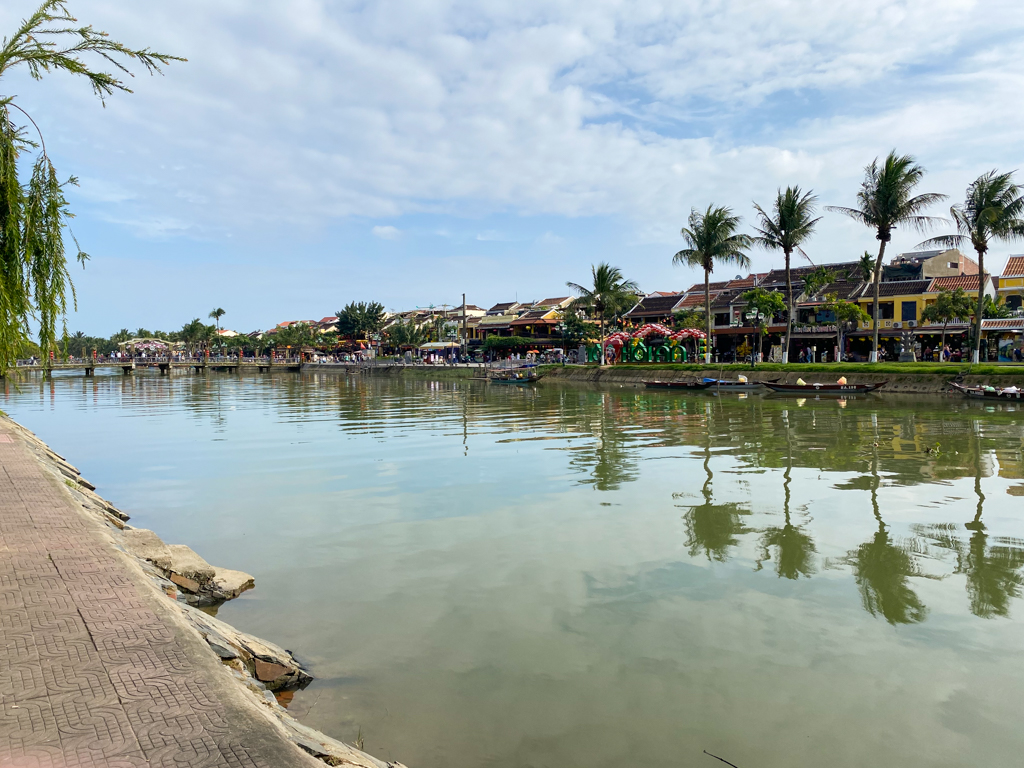
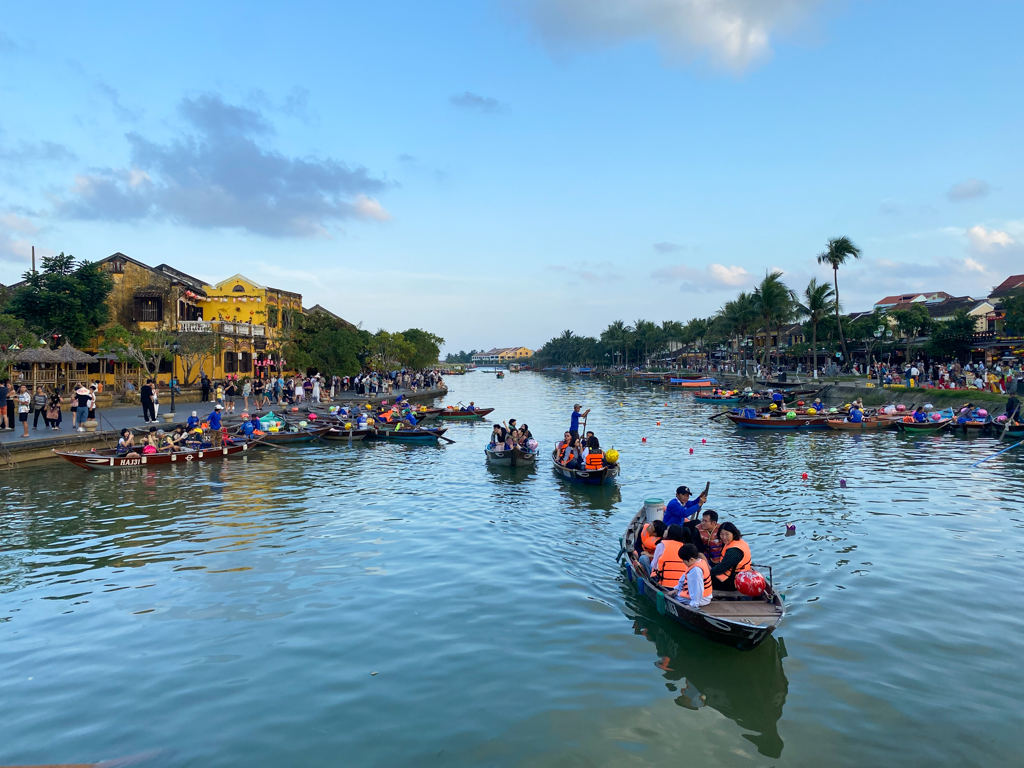 Our taxi dropped us off at our accommodation in Hội An around 2pm. We stayed at MaiChi Villa, a lovely hotel located about 5 minutes away from the Old Town. Besides its amazing location, the hotel itself is beautiful. I loved having a terrace, with hanging plants draping down. It made the whole experience feel so special.
Our taxi dropped us off at our accommodation in Hội An around 2pm. We stayed at MaiChi Villa, a lovely hotel located about 5 minutes away from the Old Town. Besides its amazing location, the hotel itself is beautiful. I loved having a terrace, with hanging plants draping down. It made the whole experience feel so special.
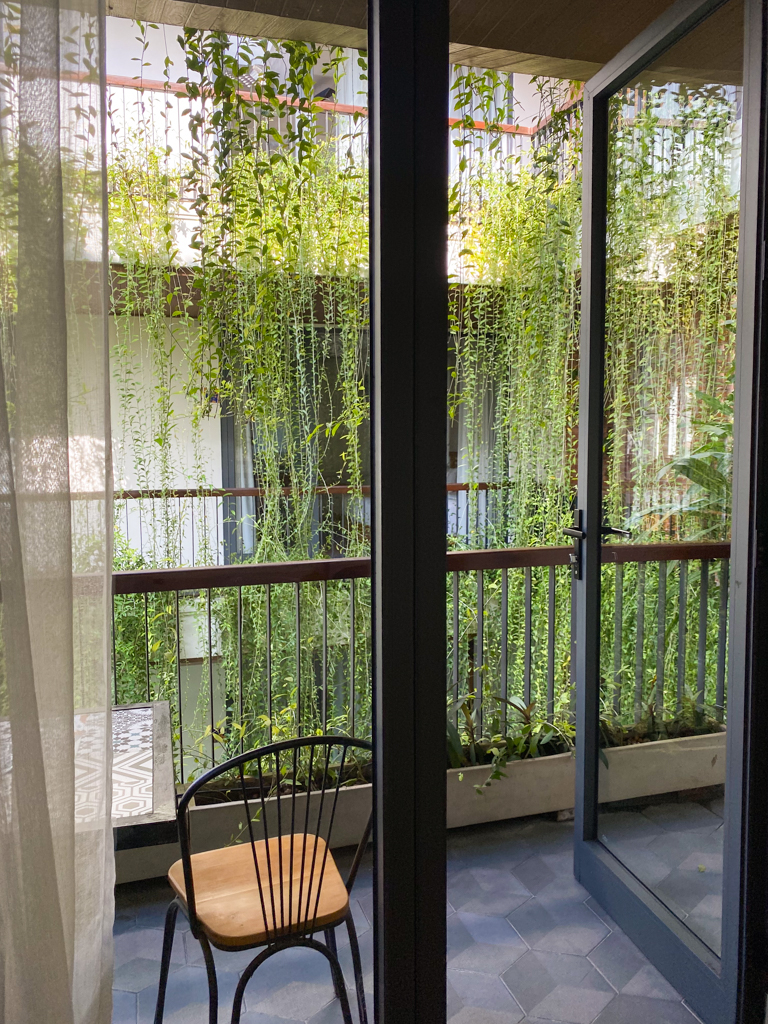 Once we checked in, unpacked and rested, we went out to walk around the famous Old Town. The best way to visit the sites in the area is to purchase a Hội An Old Town ticket for 150,000 VND from one of the dedicated ticket stalls. There are 11 ticket stalls around the outskirts of the Old Town designated walking area. They are generally small, yellow huts. I had looked into one before our trip, but unfortunately, we couldn’t locate it. A young Vietnamese woman noticed us looking around, dazed and confused, and asked if we needed help. We’re inherently suspicious, but we relayed that we were looking for this hut. She said she hadn’t seen it and said we could find one closer to the Old Town. We said thank you and started to walk away when the woman asked where we were from and all of a sudden I remembered something the host at our accommodation said. She said to be wary of locals who offer to help as inevitably they will walk you to a shop, usually a tailor shop, and coarse you into purchasing something. I quickly cut off the conversation, and apologised, but walked purposefully across the street and away from the area. We walked closer to the Old Town and a yellow hut immediately popped up and from there things were relatively smooth sailing.
Once we checked in, unpacked and rested, we went out to walk around the famous Old Town. The best way to visit the sites in the area is to purchase a Hội An Old Town ticket for 150,000 VND from one of the dedicated ticket stalls. There are 11 ticket stalls around the outskirts of the Old Town designated walking area. They are generally small, yellow huts. I had looked into one before our trip, but unfortunately, we couldn’t locate it. A young Vietnamese woman noticed us looking around, dazed and confused, and asked if we needed help. We’re inherently suspicious, but we relayed that we were looking for this hut. She said she hadn’t seen it and said we could find one closer to the Old Town. We said thank you and started to walk away when the woman asked where we were from and all of a sudden I remembered something the host at our accommodation said. She said to be wary of locals who offer to help as inevitably they will walk you to a shop, usually a tailor shop, and coarse you into purchasing something. I quickly cut off the conversation, and apologised, but walked purposefully across the street and away from the area. We walked closer to the Old Town and a yellow hut immediately popped up and from there things were relatively smooth sailing.
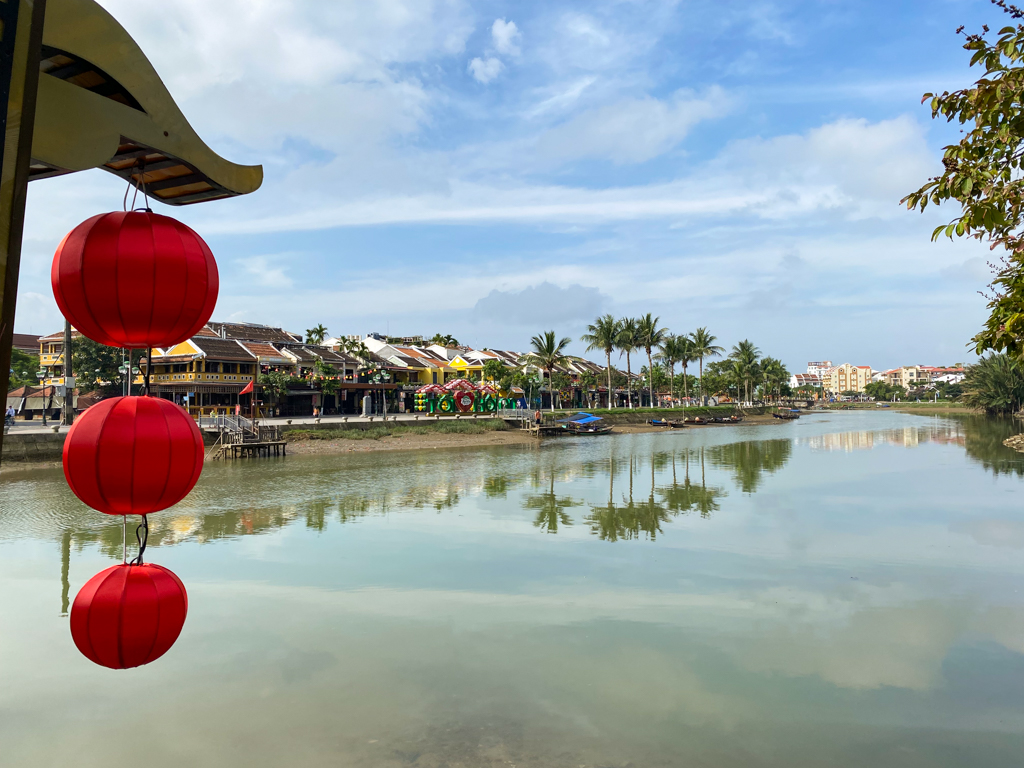 As we entered the Old Town designated walking area, we were soon overwhelmed by the number of people in the streets. There were so many tourists! I think this was a bit of a shock for us both as we hadn’t really come across any tourists yet during our trip. We quickly made our way to our first site visit to duck away from the crowds.
As we entered the Old Town designated walking area, we were soon overwhelmed by the number of people in the streets. There were so many tourists! I think this was a bit of a shock for us both as we hadn’t really come across any tourists yet during our trip. We quickly made our way to our first site visit to duck away from the crowds.
The ticket gives you entry to five sites of your choosing. It’s like a coupon system so you redeem a ticket at each site you visit until you run out of coupons. Our first stop was Hoi Quan Quang Dong, also called the Assembly Hall of the Cantonese Chinese Congregation. The assembly hall was built by Chinese immigrants in the late 18th century. The main altar is dedicated to Quan Cong, a revered Chinese general who represents virtues like sincerity, loyalty, integrity, and justice.

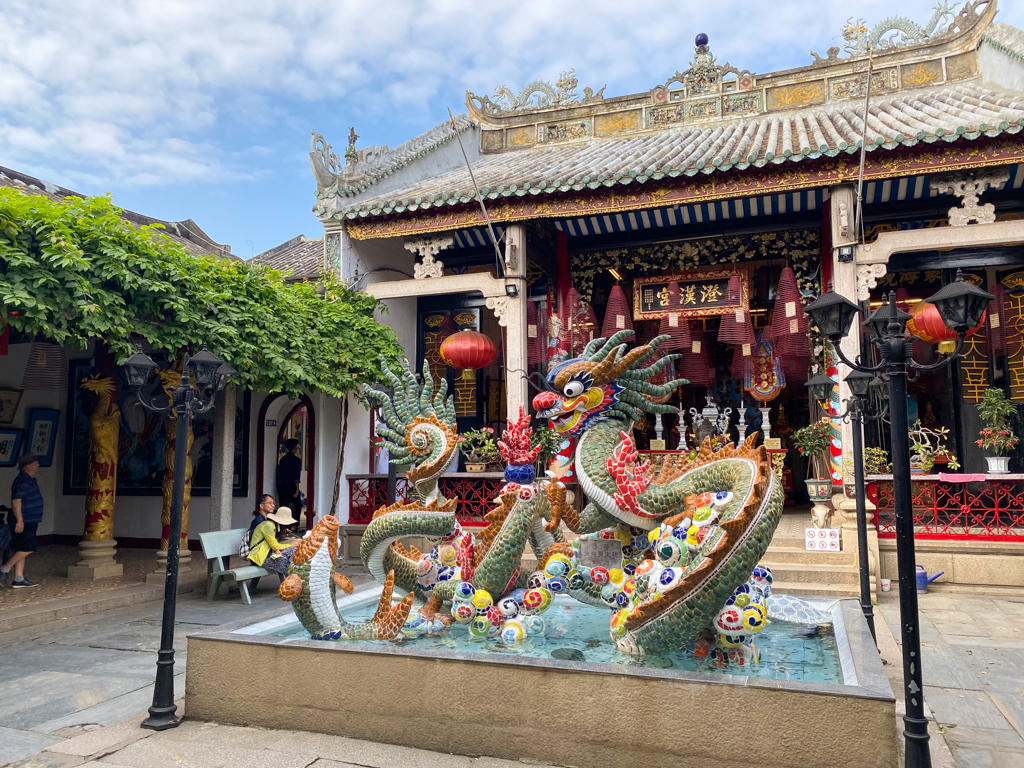 The assembly hall has an airy, tall entrance, which opens up to a wonderful garden with the most beautiful mosaic statue of a dragon. I wasn’t too sure if it was a dragon with multiple heads or, rather, multiple dragons, but nonetheless, the statue is so dynamic with the serpent-like bodies dipping in and out of the pond and claws reaching for the air.
The assembly hall has an airy, tall entrance, which opens up to a wonderful garden with the most beautiful mosaic statue of a dragon. I wasn’t too sure if it was a dragon with multiple heads or, rather, multiple dragons, but nonetheless, the statue is so dynamic with the serpent-like bodies dipping in and out of the pond and claws reaching for the air.

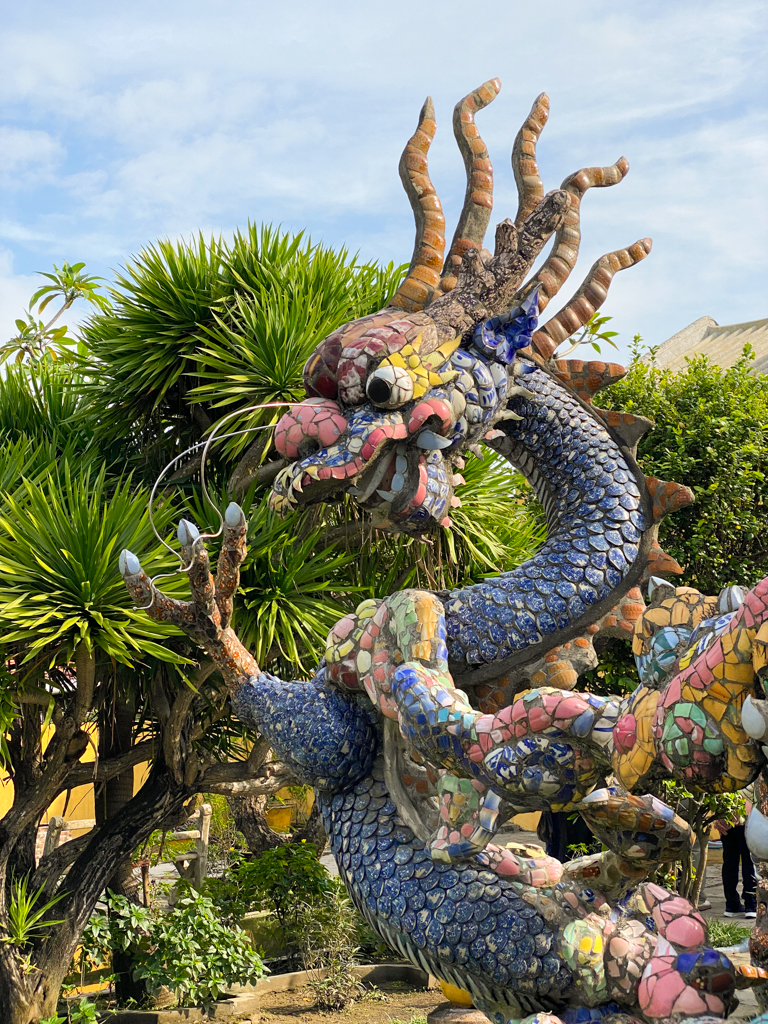
Our second stop was Tan Ky House. It’s a beautiful, old house that was built over 200 years ago by a Vietnamese family and has been preserved for seven generations. The house has Japanese and Chinese influences in the architecture. My favourite aspect of the house is the Chinese poems written in inlaid mother-of-pearl hanging from some of the columns that hold up the roof. The Chinese characters on these 150-year-old panels are formed entirely of birds gracefully portrayed in various flight positions.

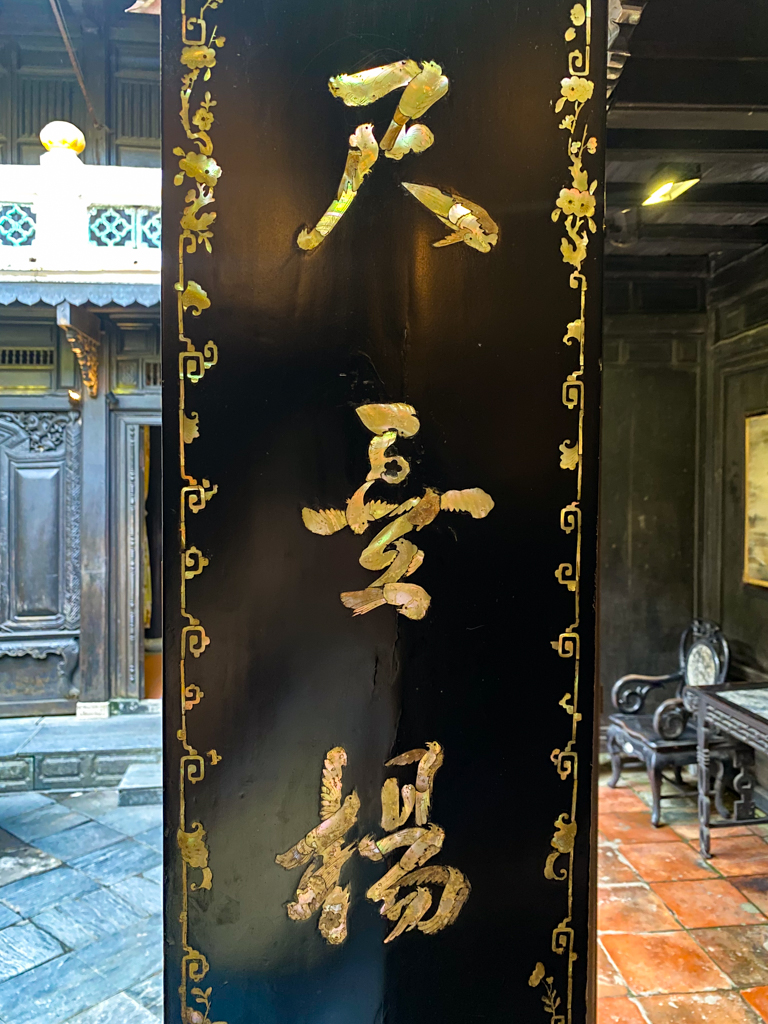
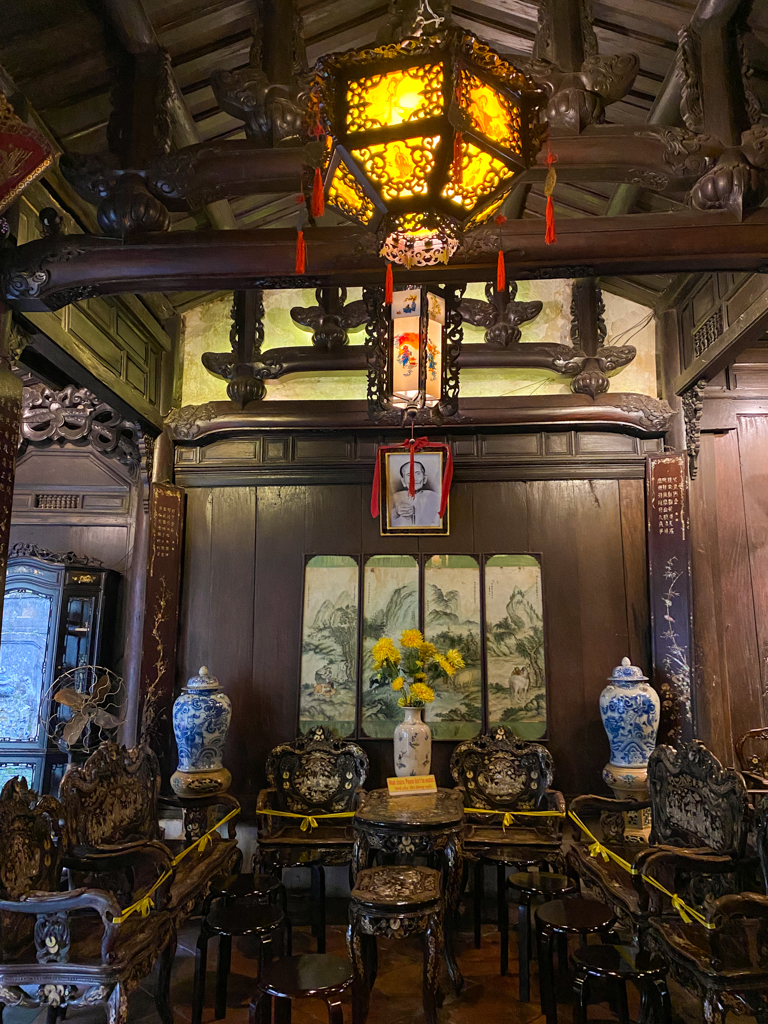

Up next, we visited Hoi Quan Phuoc Kien which is also called the Assembly Hall of the Fujian Chinese Congregation. Fujian (Phuc Kien or Phuoc Kien in Vietnamese) refers to a coastal province in Southern China and the ethnic group from that area. In China, the Qing Dynasty won a pivotal war against the Ming dynasty in 1649. After the Ming Dynasty collapsed, many Fujian families migrated to Southeast Asia, including Vietnam. Lord Nguyen, the ruler of the Inner Realm (Central and Southern Vietnam), allowed these immigrants to settle in Hội An and establish a village. The assembly hall was built for Fujianese immigrants to socialise and trade and they would’ve mostly been merchants by profession.
The assembly hall was later restored and reopened as a temple, named Hoi Quan Phuoc Kien, in 1759. The temple was dedicated to the worship of Thien Hau, a Chinese sea goddess who blesses fishers and sailors with safe ocean travel.
 The impressionable green-tiled triple gateway dates from 1975. The gate is carved with sculptures of sacred animals such as dragons, unicorns, turtles, and phoenixes. Above an eye-catching plaque written “福建會館” (Fujian Assembly Hall), there is a dragon’s head holding a red ball, symbolising the sun. The left and right sides have two circles of the moon and sun symbols, symbolising “Yin” and “Yang” – the natural harmony in the universe.
The impressionable green-tiled triple gateway dates from 1975. The gate is carved with sculptures of sacred animals such as dragons, unicorns, turtles, and phoenixes. Above an eye-catching plaque written “福建會館” (Fujian Assembly Hall), there is a dragon’s head holding a red ball, symbolising the sun. The left and right sides have two circles of the moon and sun symbols, symbolising “Yin” and “Yang” – the natural harmony in the universe.
There are numerous areas within the assembly hall complex. The inner courtyard is filled with plants and ornaments. The East and West halls are used for community meetings. The rear hall is a separate shrine to the Fujian generals who dedicated their lives to the restoration of the Ming Dynasty, but ultimately failed and fled to Hội An.
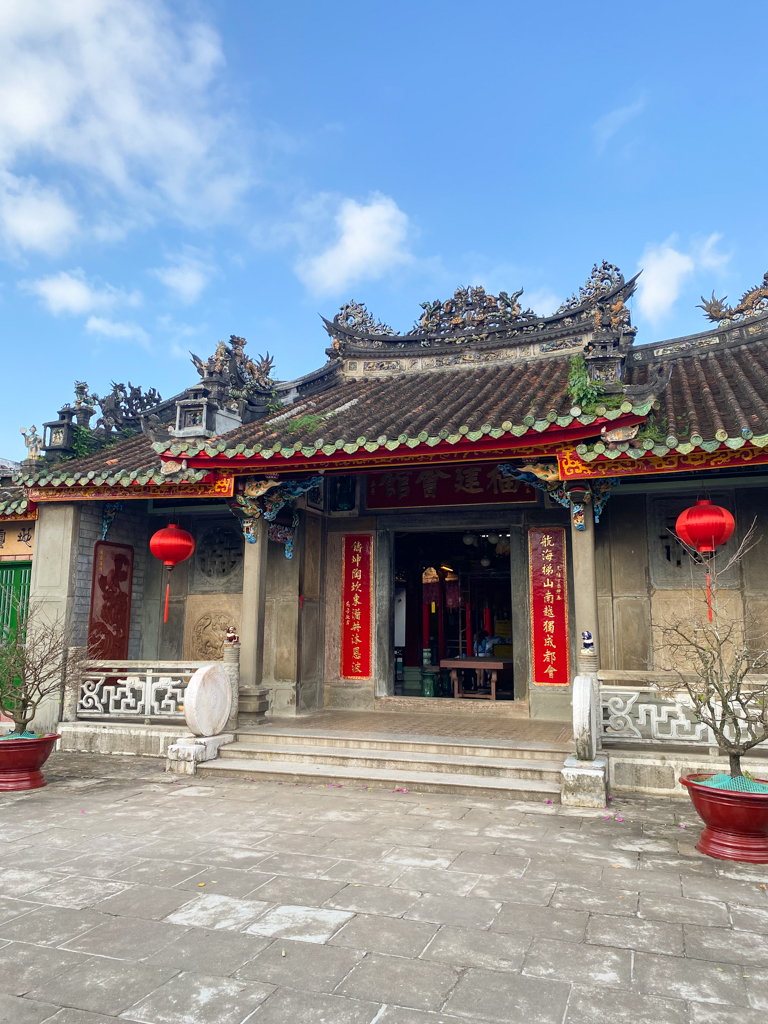
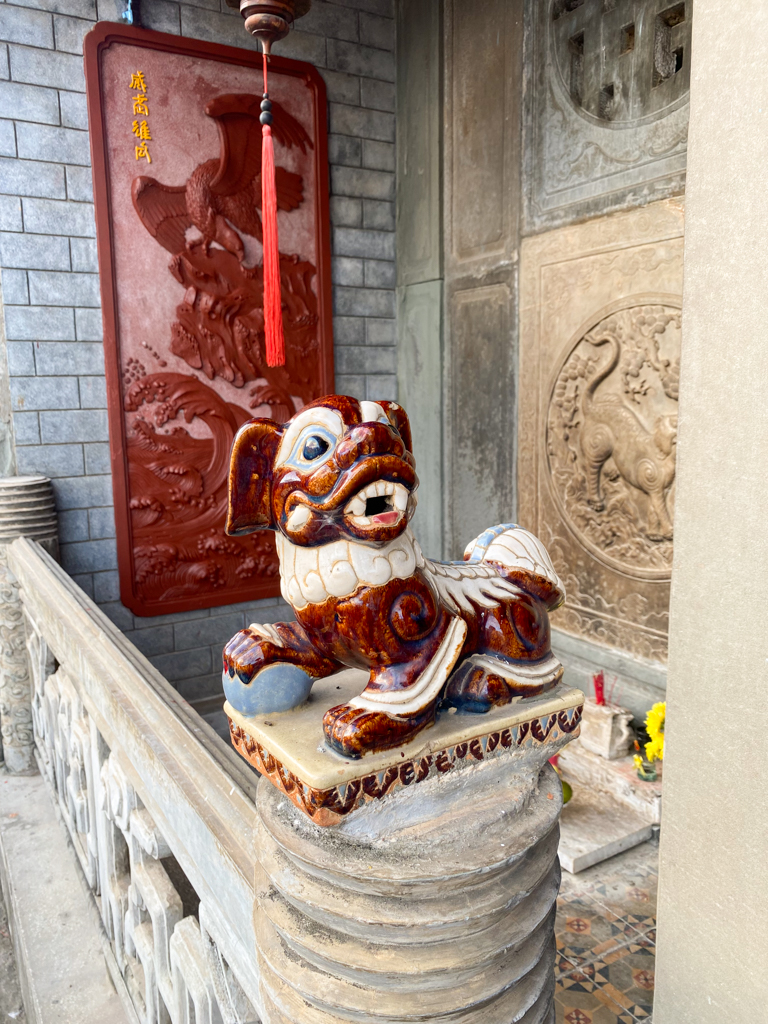
One of the chambers contains a statue of Thien Hau. To either side of the entrance stand two figures: red-skinned Thuan Phong Nhi and green-skinned Thien Ly Nhan, deities who alert Thien Hau when sailors are in distress. In the final chamber, the central altar contains seated figures of the heads of the six Fujian families. The smaller figures below them represent their successors as clan leaders.
The complex is impressive and full of symbols and illustrations from Chinese and Vietnamese mythology and lore. This assembly hall is the most impressive in Hội An, so it’s definitely not a spot to miss!

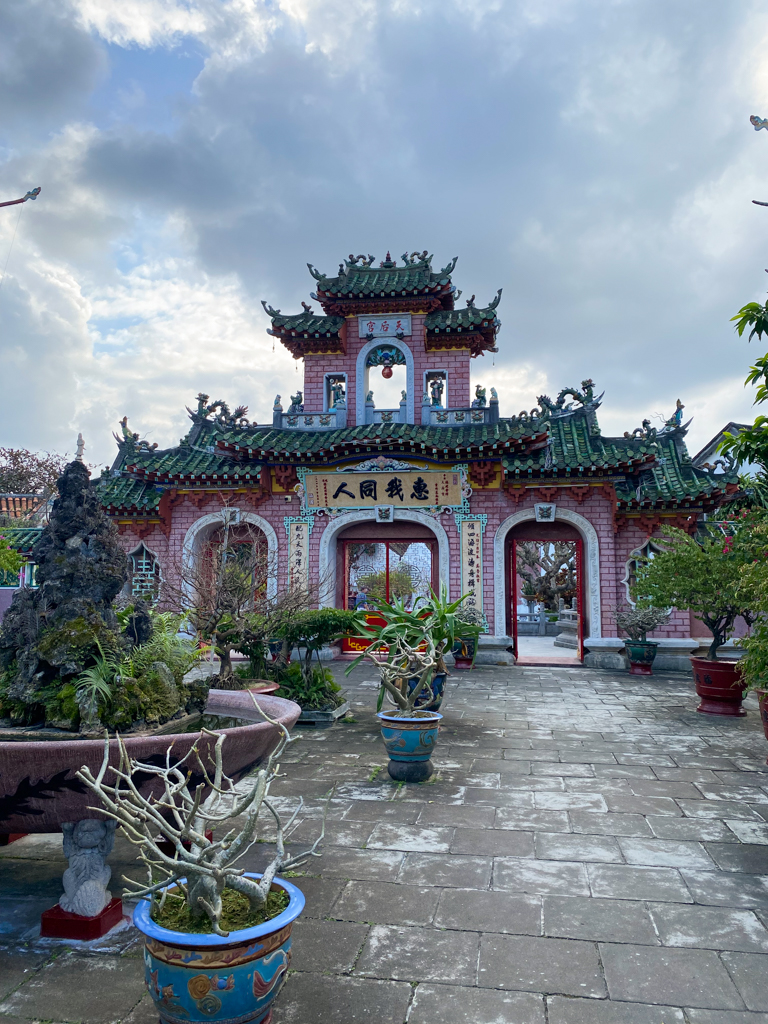
Our fourth stop was the Quan Cong Temple. Founded in 1653, this small temple is dedicated to Quan Cong, just like the altar at the Hoi Quan Quang Dong. He is depicted via a gilded statue, made of paper mâché on a wooden frame, on the central altar at the back of the sanctuary.
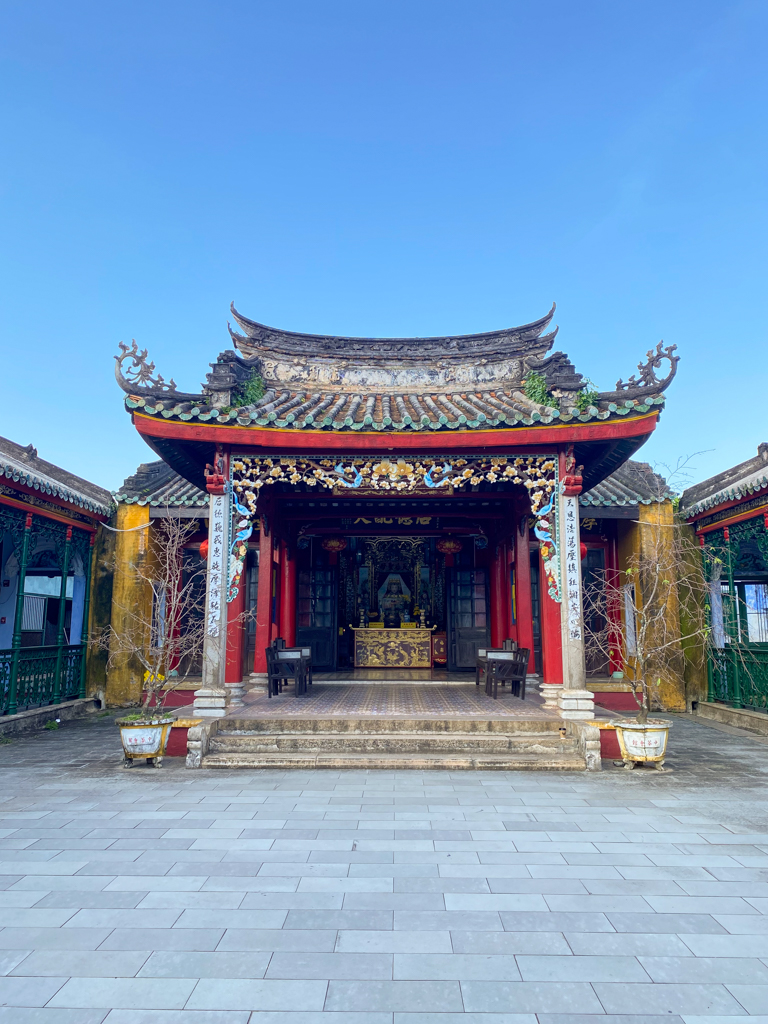
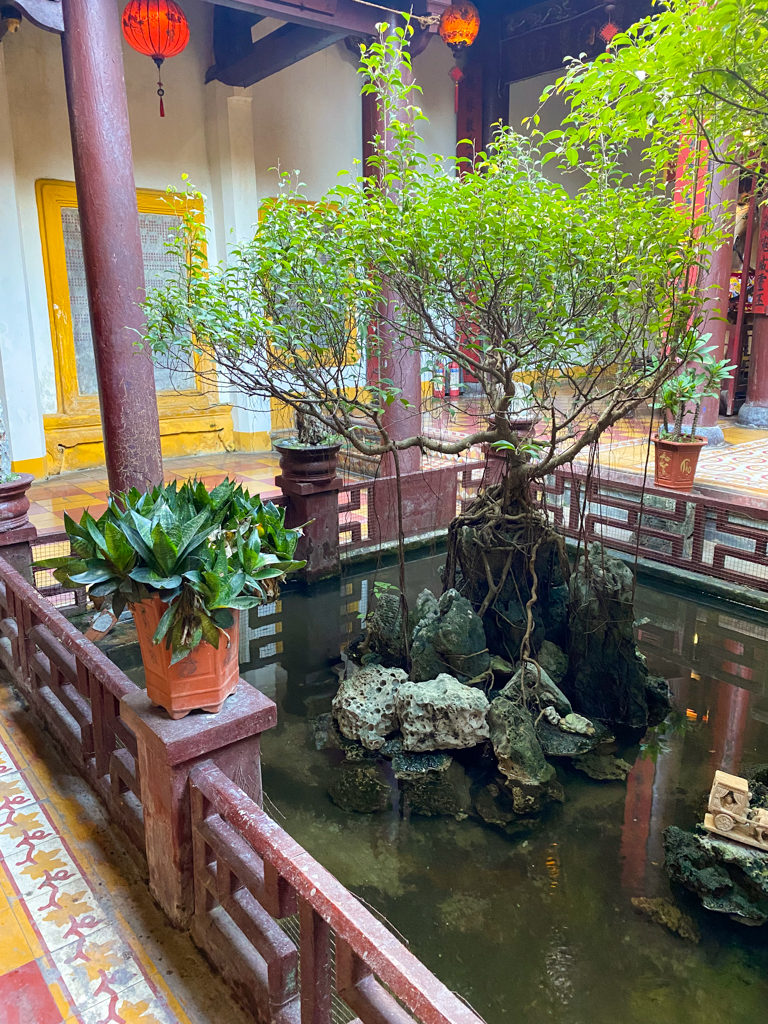
For our final stop, we visited another smaller site called Quan Thang Ancient House. The house is three centuries old and was built by a Chinese captain. Like the other house we visited, the architecture includes Japanese and Chinese elements.
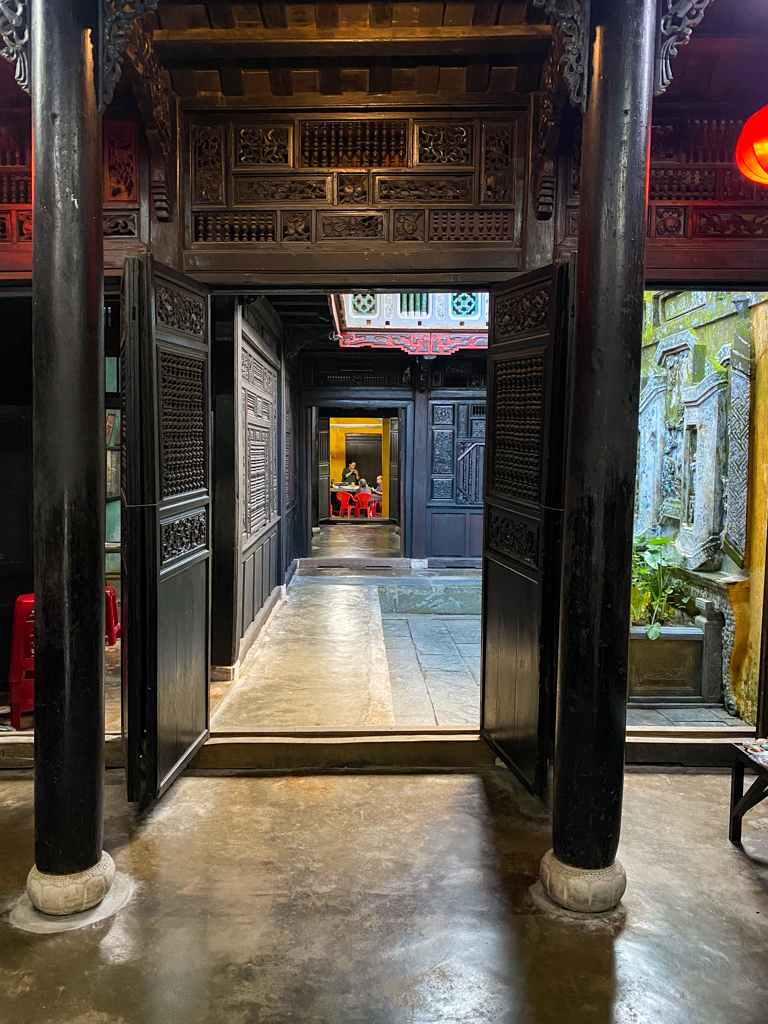

After we finished exploring the house we stopped at a famous institution in Hội An: Mót. It’s a tea shop serving a very unique concoction made of herbs such as chamomile, monk fruit, green tea leaves, cinnamon, liquorice, cinnamon stick, and lemongrass. As we approached to order we could see so many bees swarming around, I’m sure because of all the sugar they could detect!
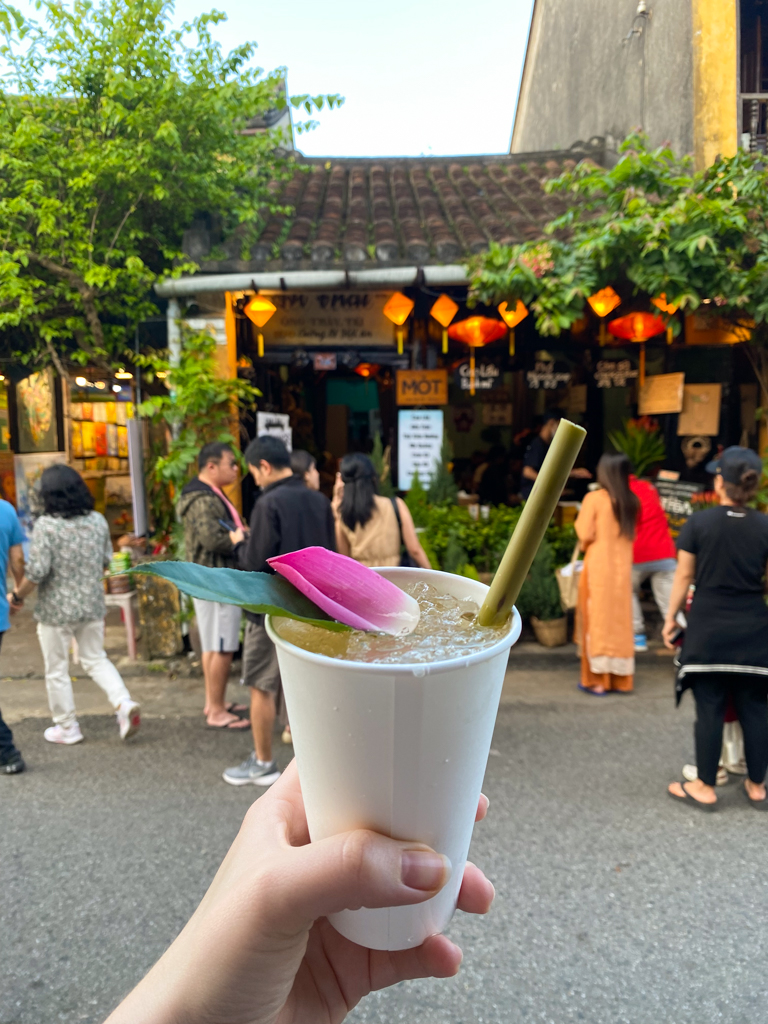
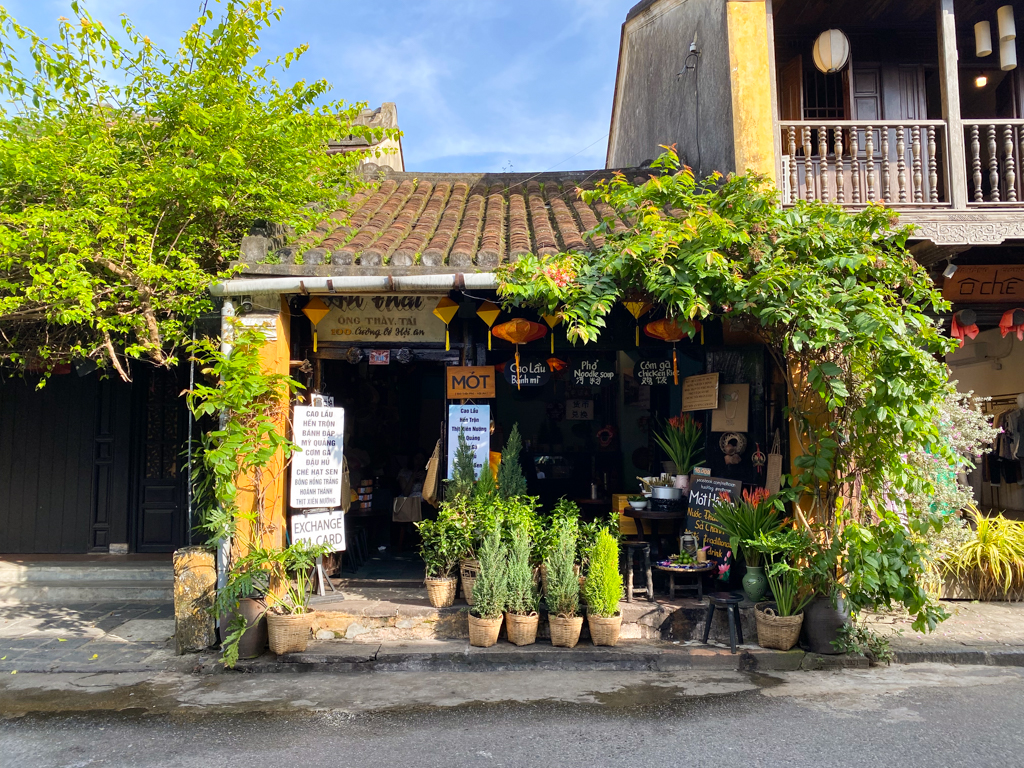 By this time the sun was just about to set, so we walked around at this beautiful time of day and then went back to our accommodation to rest up before dinner. After a couple of hours, we ventured back out to see all the hubbub of the evening.
By this time the sun was just about to set, so we walked around at this beautiful time of day and then went back to our accommodation to rest up before dinner. After a couple of hours, we ventured back out to see all the hubbub of the evening.
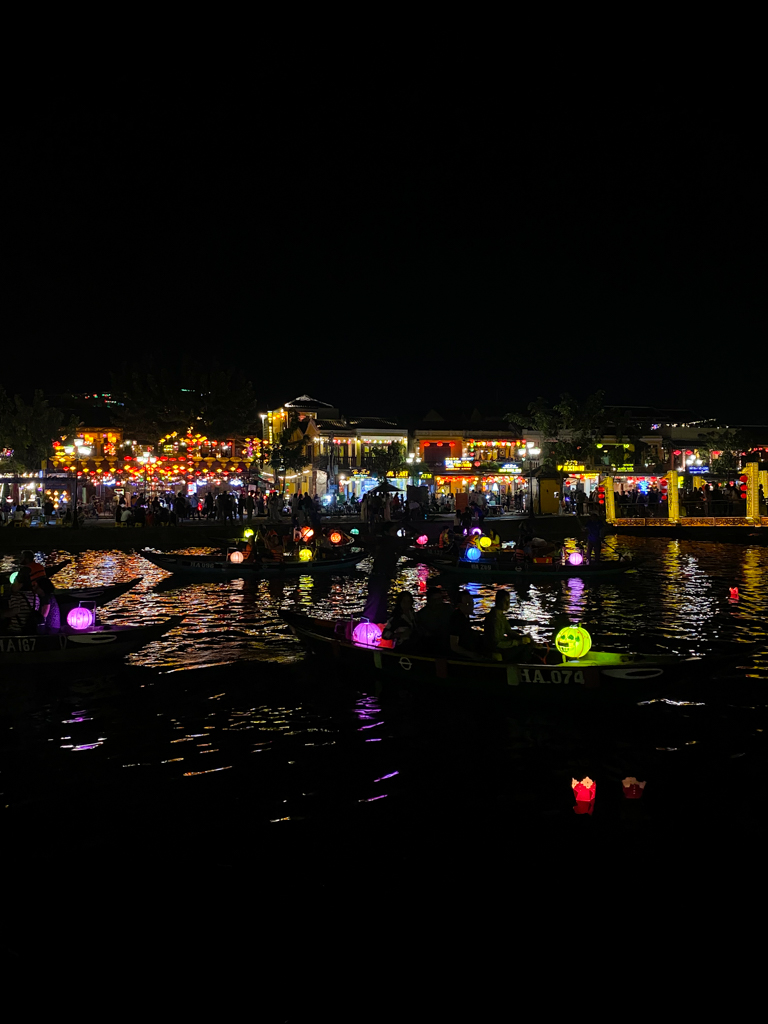
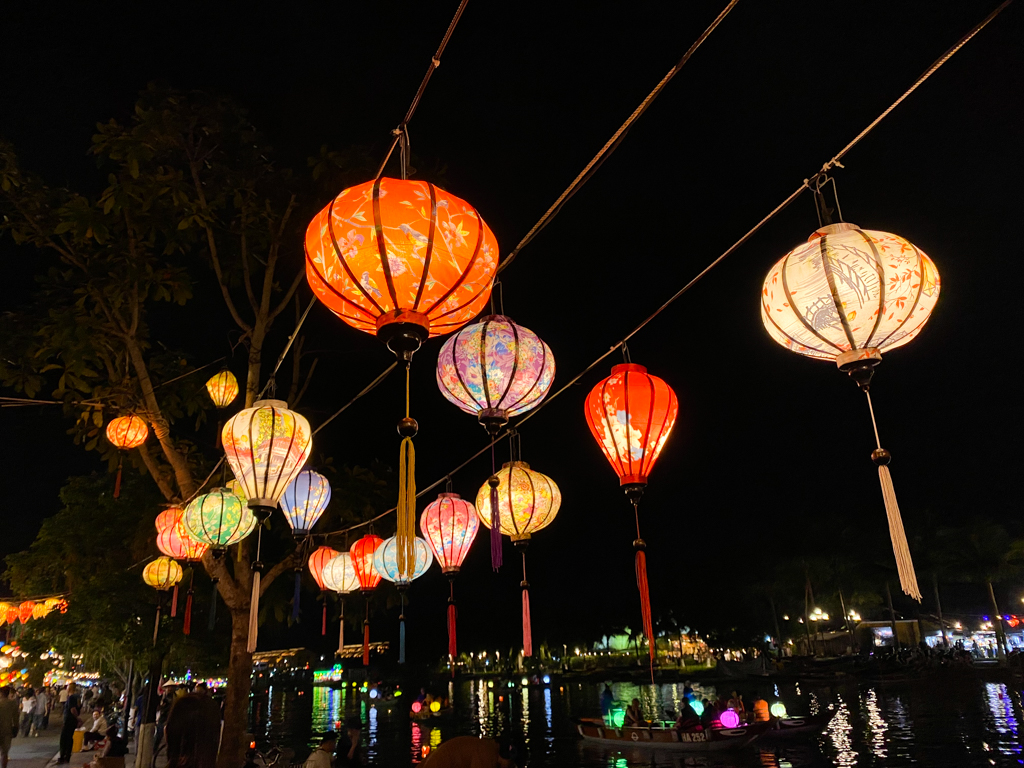
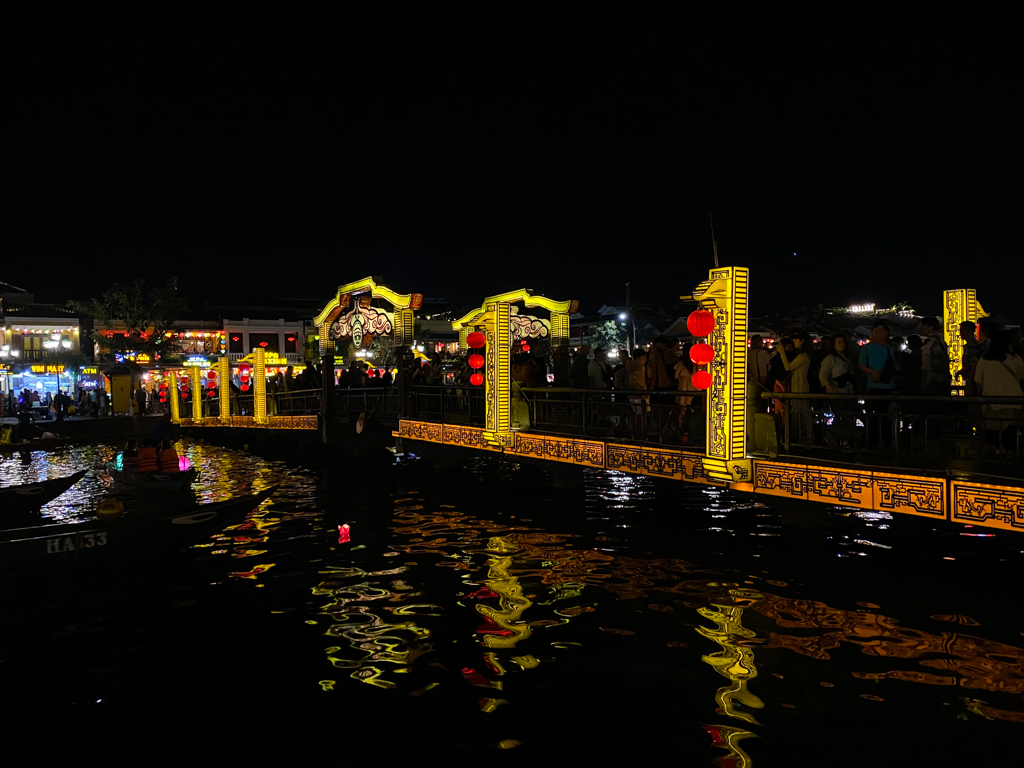
We went for dinner at Quán Cao lầu Bá Lễ to try a famous Hoi An Dish, cao lầu. It’s a noodle dish that usually consists of pork and greens on a bed of rice noodles made from rice that has been soaked in lye water. The consequence of using this rice is that it gives the noodles a chewy, springy texture. However, it wasn’t our favourite. But stay tuned for the next day’s dinner, because that place I would recommend! After a disappointing dinner, we checked out Tiệm Chè Xíu (also called RIN gelato) for a classic Vietnamese dessert, chè. I discussed what chè exactly is in my blog post on Can Tho, but essentially it’s a sweet dessert soup. I ordered the Chè Khoai Dẻo Đậu Đỏ (quite the mouthful), which is red bean and sweet potato with fresh coconut milk. It had rice balls and jellies, and it was so delicious. I tried to find a place like it everywhere I went in Vietnam but nowhere compared to Tiệm Chè Xíu.
 The next morning we woke up bright and early to go for breakfast. Because our dinner spot was not great we were pretty skeptical about relying on the internet’s reviews and blog posts. Luckily, our host recommended a few places in Hội An when we arrived so we had these spots to rely on. In particular, our host recommended a bánh mì place that she said is just as good as the most famous places. It’s actually right next to the chè place and is called Bánh Mì Sum. They bake their own baguettes and offer a variety of fillings, including the Hội An classic which is a mix of egg sauce, pate, vegetables, papaya, cucumber, pork, ham, chicken, and more pork, but barbequed. I got a vegetarian version with egg sauce, cheese, and eggs. This was our best bánh mì in all of Vietnam!
The next morning we woke up bright and early to go for breakfast. Because our dinner spot was not great we were pretty skeptical about relying on the internet’s reviews and blog posts. Luckily, our host recommended a few places in Hội An when we arrived so we had these spots to rely on. In particular, our host recommended a bánh mì place that she said is just as good as the most famous places. It’s actually right next to the chè place and is called Bánh Mì Sum. They bake their own baguettes and offer a variety of fillings, including the Hội An classic which is a mix of egg sauce, pate, vegetables, papaya, cucumber, pork, ham, chicken, and more pork, but barbequed. I got a vegetarian version with egg sauce, cheese, and eggs. This was our best bánh mì in all of Vietnam!
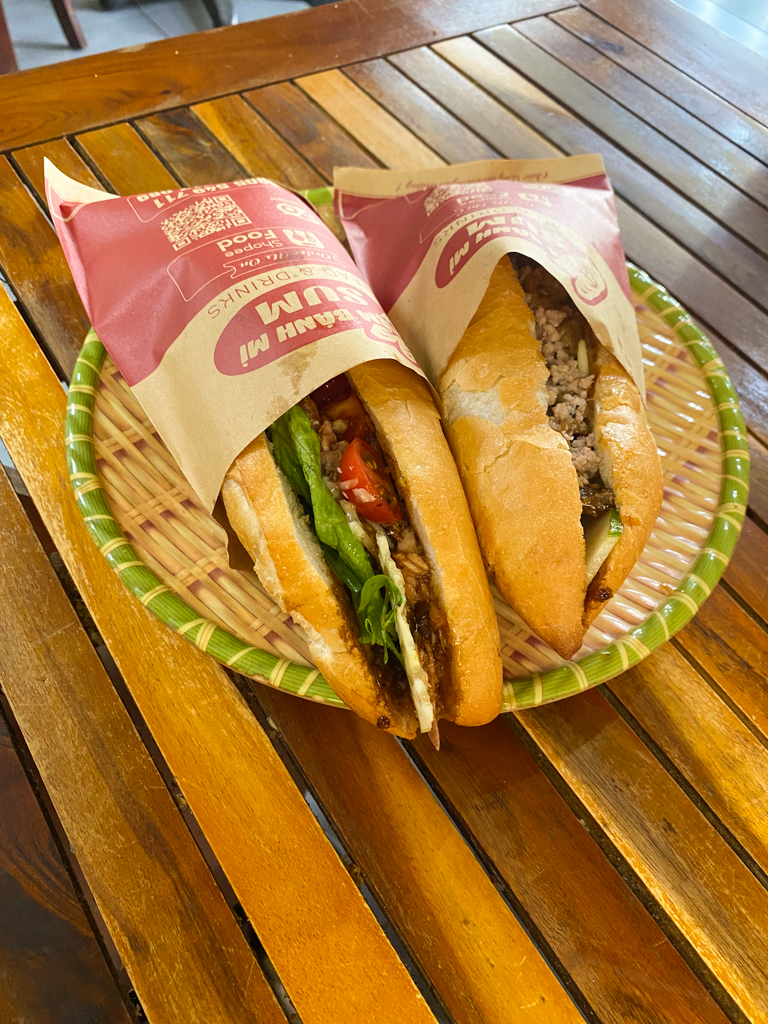
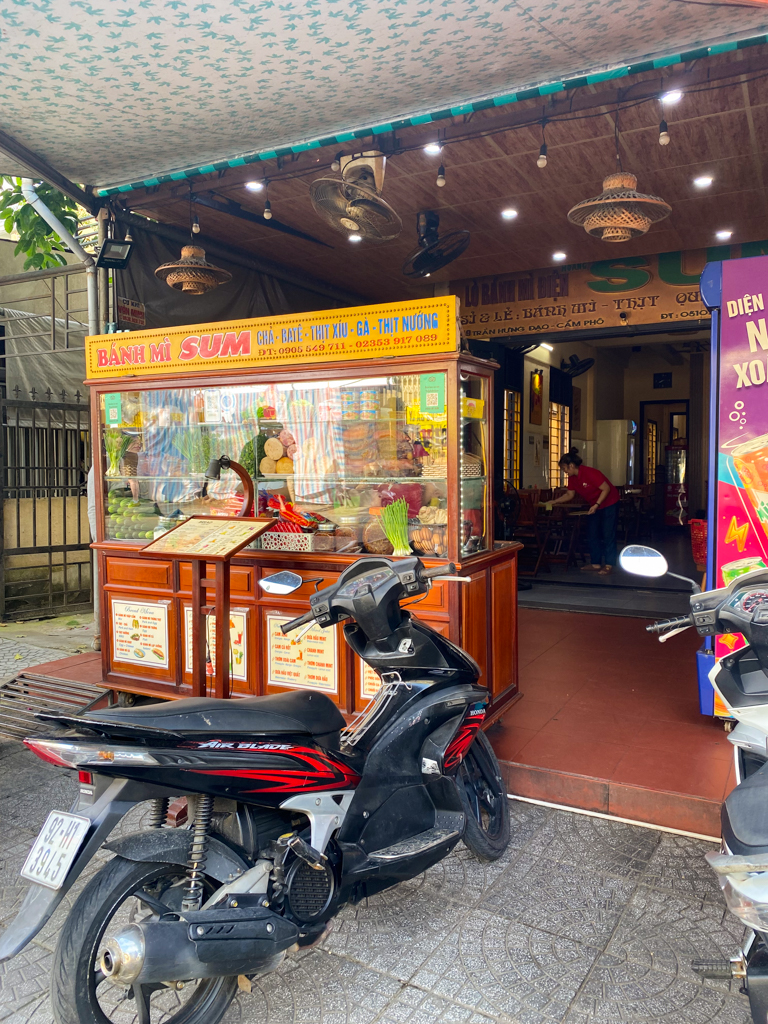
We then walked through the Old Town to see if we could enjoy the streets without the hordes of tourists. This was a great idea because the village was sleepy, which was just what we wanted. I have to admit, I had some major reservations about Hội An because of all the tourists. But seeing the beautiful buildings and streets made me see some charming characteristics of this place.
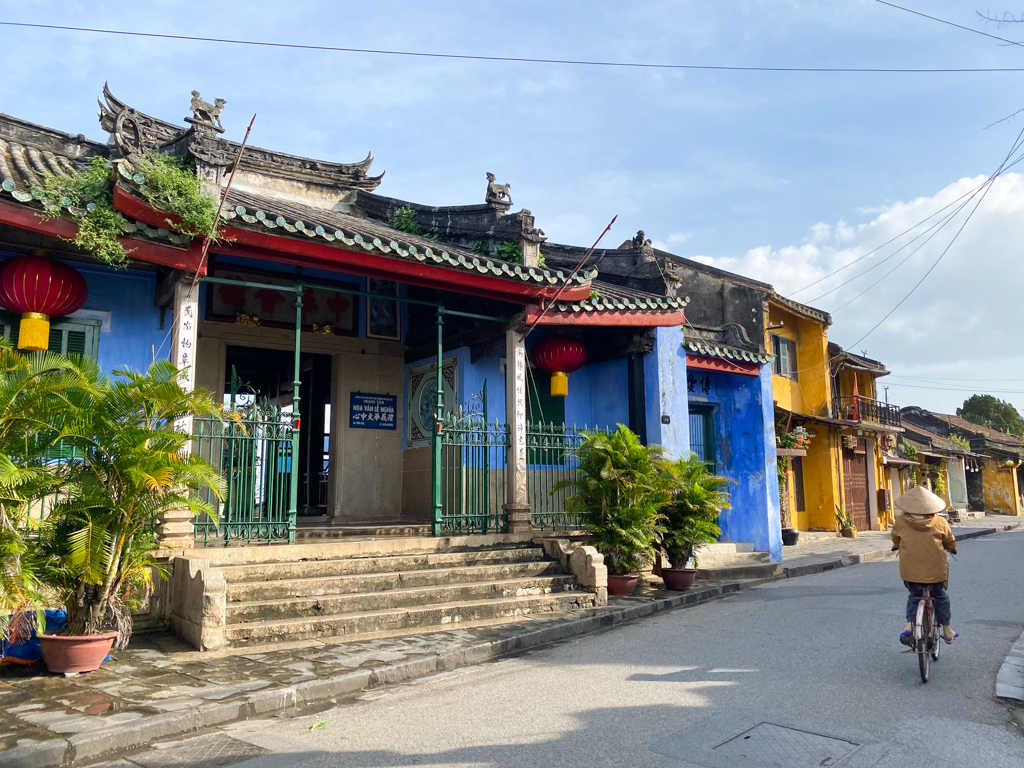


We stopped for coffee at Phin Coffee Restaurant. I was having a bit of an off day mentally so it was nice to relax on their elevated terrace to relax and enjoy a nice cup of coffee. The Winnie the Pooh espresso cup didn’t hurt.


We then went back to our accommodation, picked up a couple of bikes, and started making our way to An Bang Beach. The beach is just 3km (~1.86 miles) north of town, which makes for a very pleasant bike ride. We biked past numerous rice fields and farm plots with lots of water buffalo!
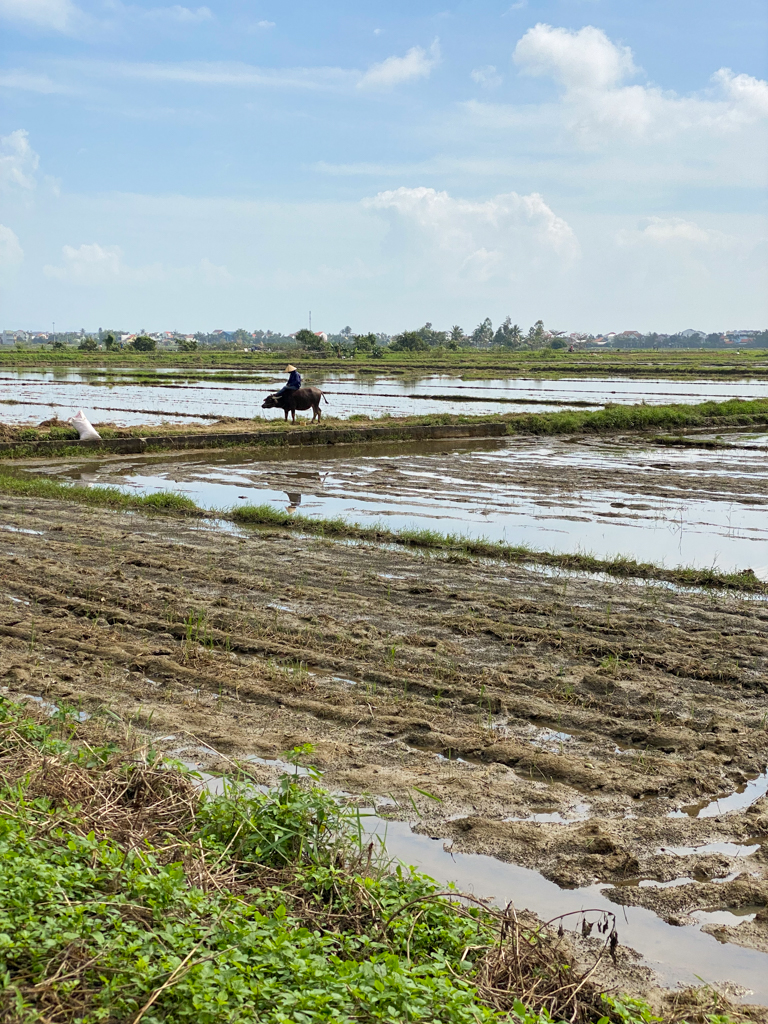
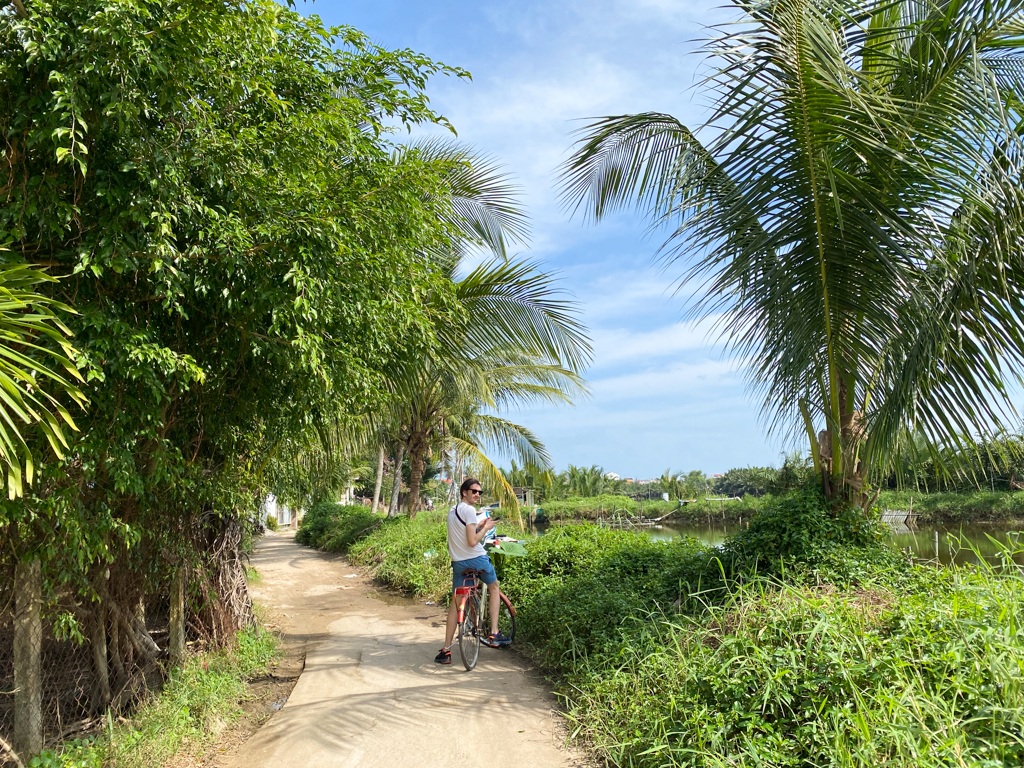
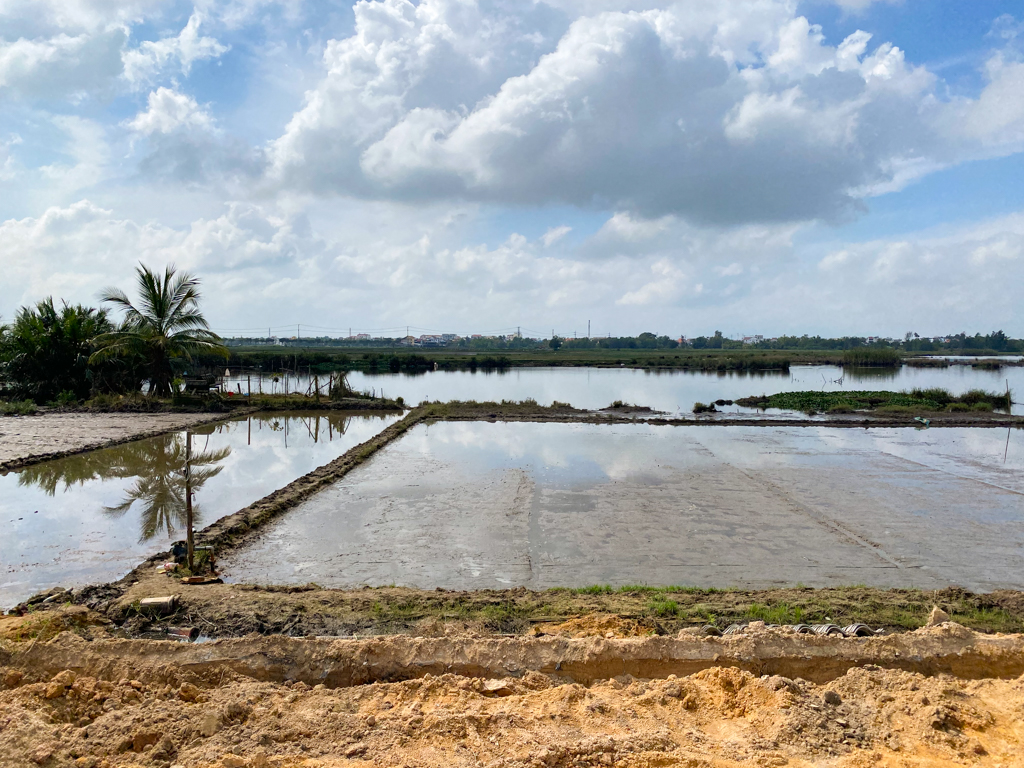
We also biked through the Tra Que Vegetable Village. I’m not exactly sure how this area started, but the village is a working vegetable farm where none of the farmers use any chemicals or harsh fertilisers. Instead, they use organic methods and in particular a special type of algae found in a nearby lagoon. The algae, combined with the ultra-nutrient soil, helps the vegetables grow in abundance. The result is fields of vibrant, green vegetables.
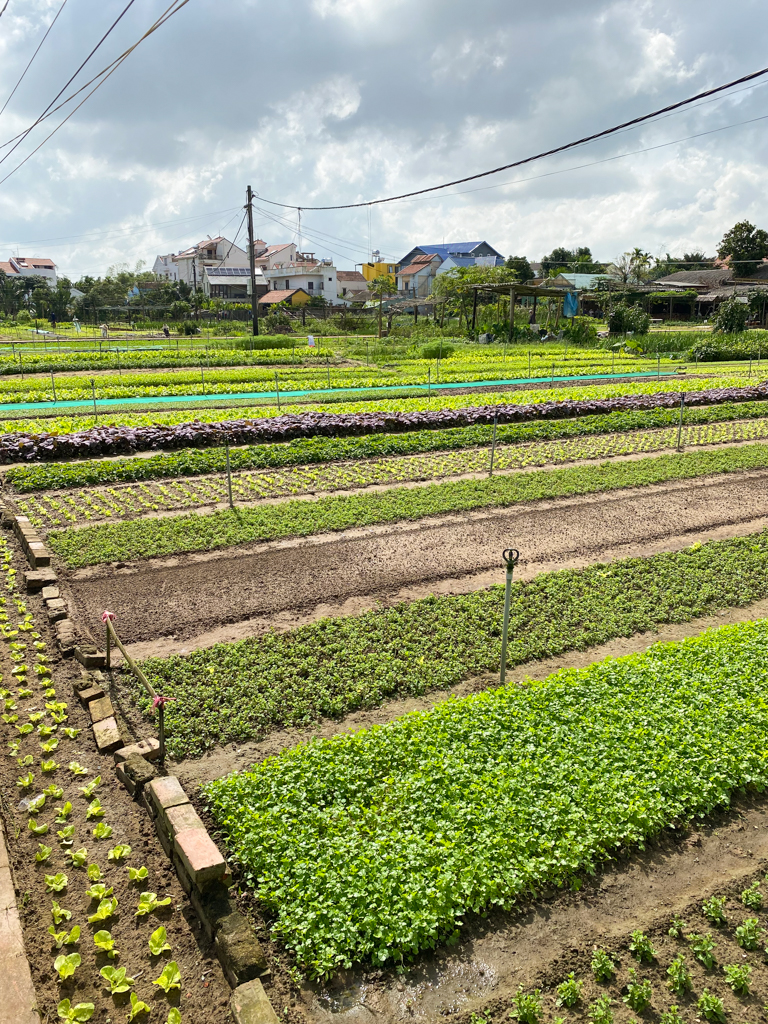

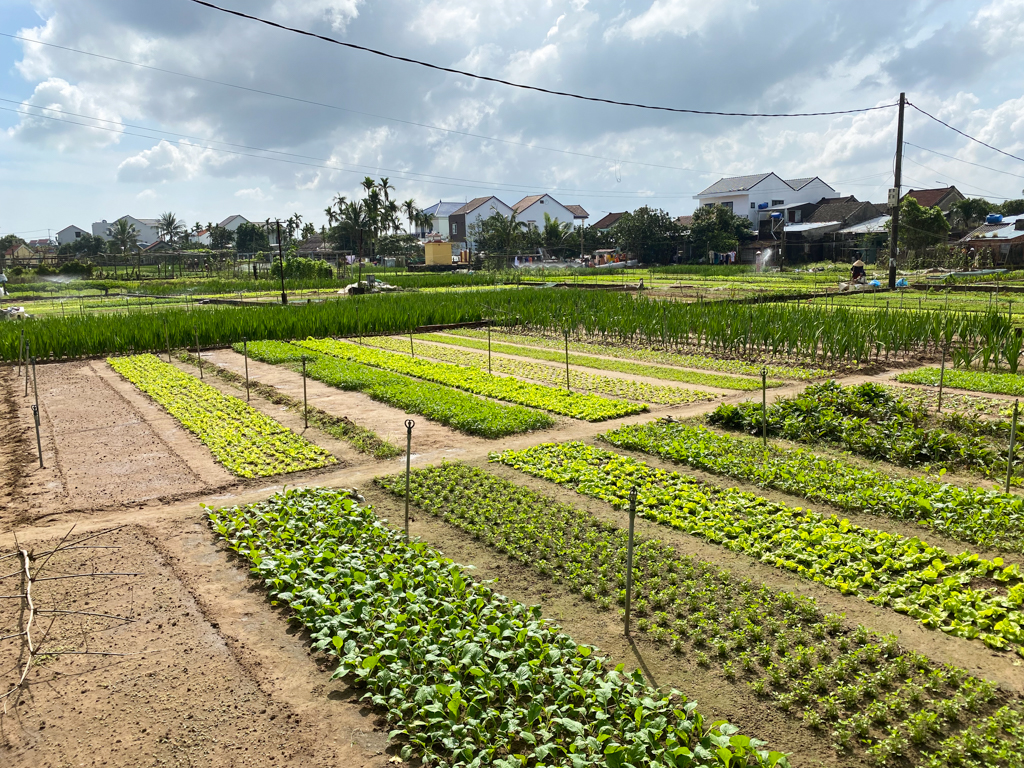
We finally arrived at An Bang Beach at around midday. We decided to park our bikes at Dolphin Kitchen & Bar, a bar with access to the beachfront. If you buy drinks and/or food to keep them happy they’ll look after your bike and give you a lounge chair, umbrella, and towel. While the bar is not fancy, it has everything you could need and I had no complaints. I didn’t go for the food, but then again I wouldn’t buy food at any bar along the beach. Instead, I opted for a mango smoothie, which was delicious.
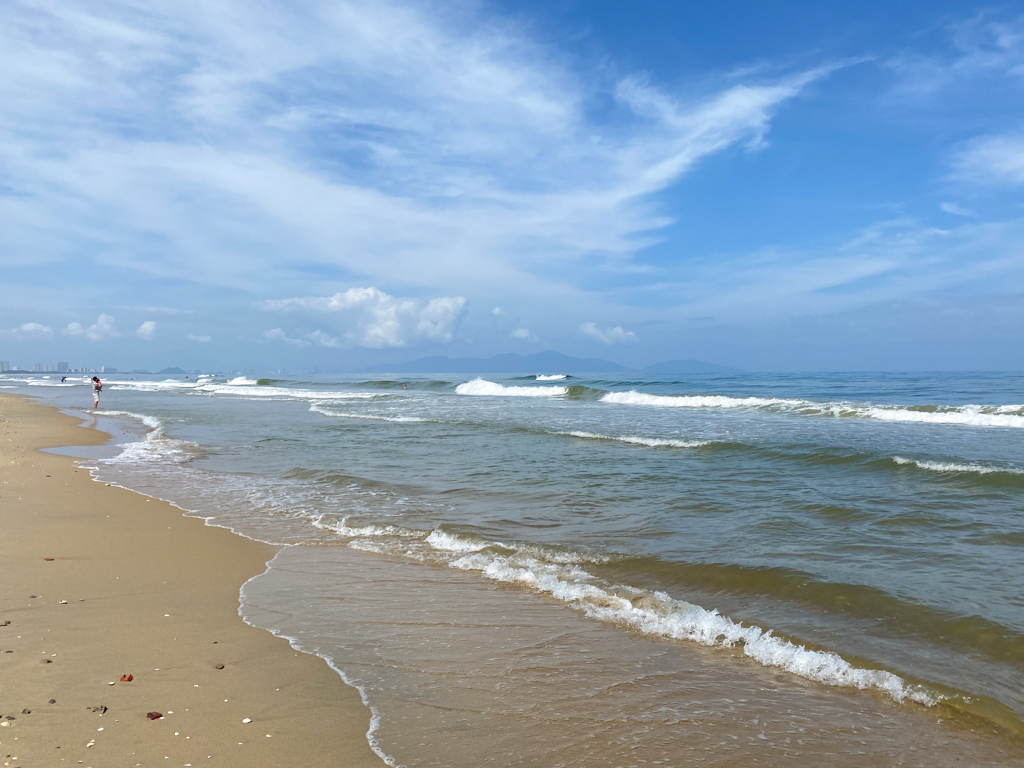
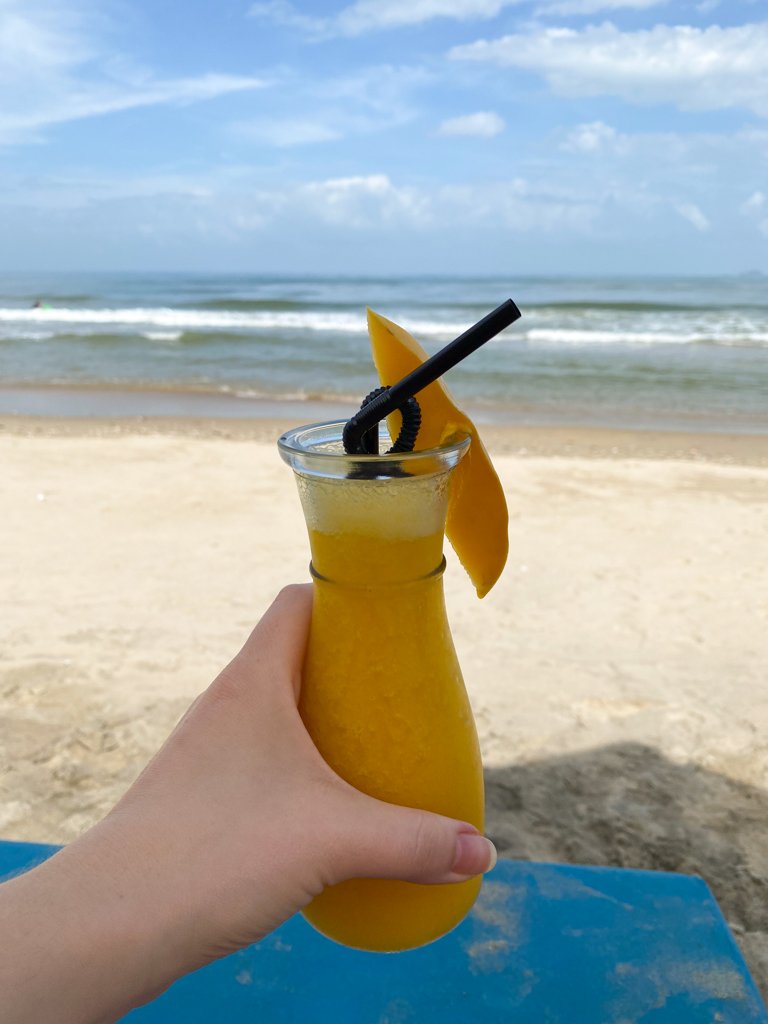
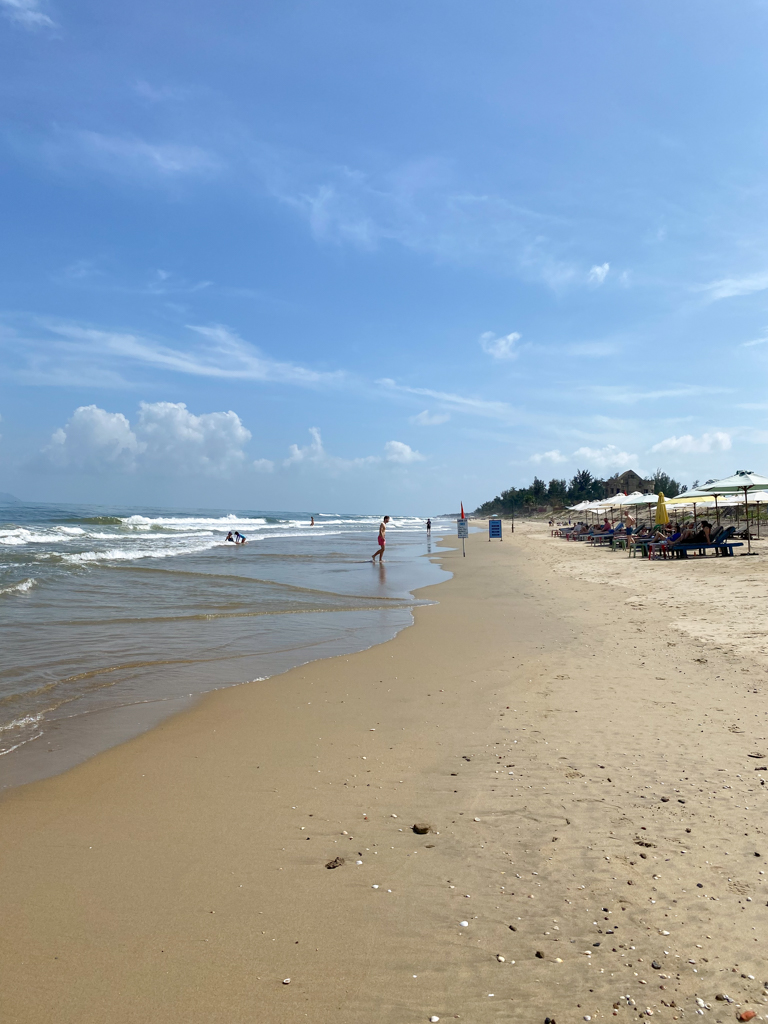
At around 1:30pm, it was time to cycle back towards Hội An and look for lunch. We decided to stop again at the Tra Que Vegetable Village because we had read that many restaurants here use the fresh produce surrounding them.
We chose a restaurant called Baby Mustard. Only one other family was eating, so we were a little hesitant, but as soon as we peered through to see a garden in the back we felt confident in our choice. We ordered the đậu hũ nhồi hạt sen (fried tofu w/ lotus seed filling w/ tomato sauce). Đậu phụ means tofu and hạt sen means lotus seeds. The tomato sauce was incredible and I would time and time again find this amazing sauce throughout Central Vietnam. We also ordered the cá thu nướng lá chuối (grilled mackerel in banana leaf marinated with turmeric powder). Both dishes were delicious and way better than expected. I would definitely recommend this place if you’re looking for a satisfying and scrumptious meal on the way or on the way back from An Bang Beach.

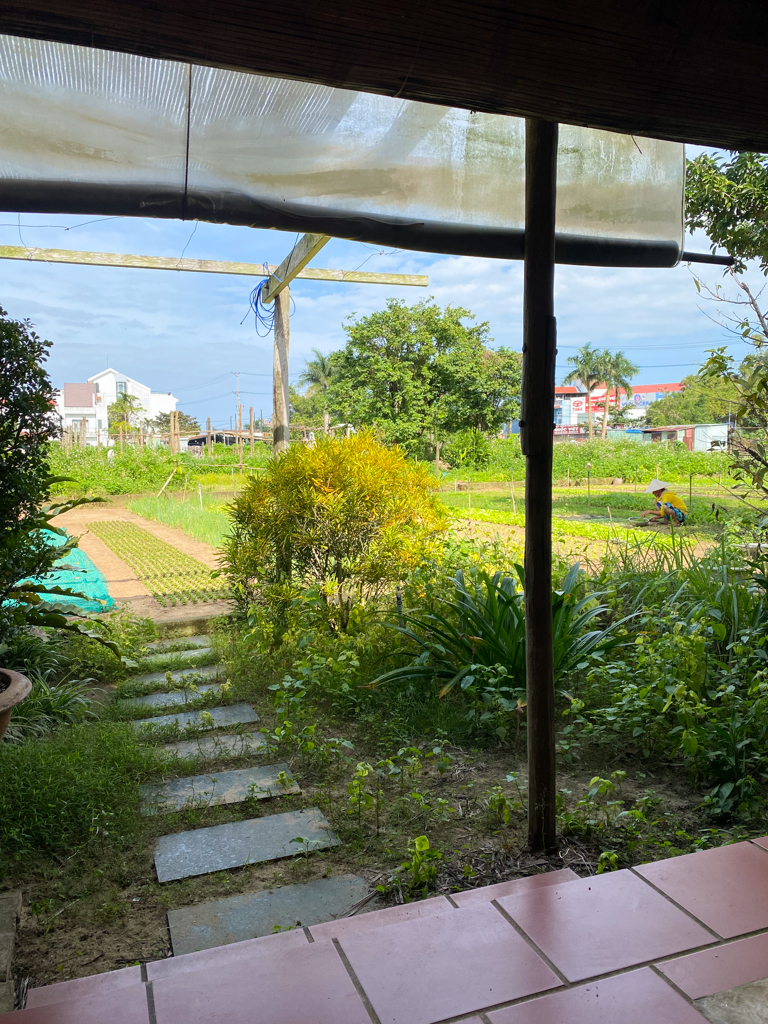
We arrived back in Hội An around 3:30pm and decided to take a break and rest at our accommodation. It was during this time that I realised I was seriously sunburned. Even though I was under the umbrella almost the entire time and if I wasn’t I was in the sea, my legs still received harsh, indirect sunlight for a few hours. Victor went out on a mission to find aloe vera and while he couldn’t find Banana Boat, he did find a lotion that I could use until we could locate a better option. Unfortunately, my burns just got worse and worse throughout the evening. What a way to end the day!
Nonetheless, after rinsing my legs under cold water for a long time, we ventured out on one last walk through the town. The sun had set below the horizon as we watched all the tourists flock into the lantern-decorated boats once again.
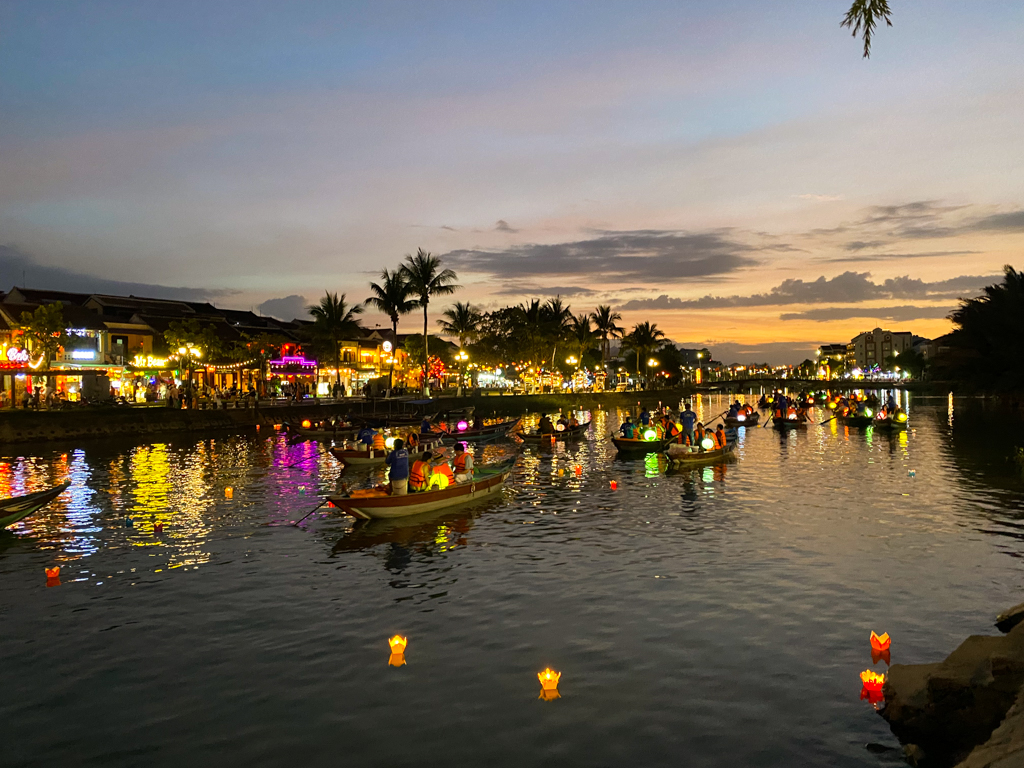 For dinner, we decided to try another cao lầu place because the one the day before was not very good. We went to Mì Quảng Ông Hai, a noodle shop on the edge of town. Victor ordered the cao lầu and I got the mì quảng (for more information on this dish, read my other blog post). I tried a bit of Victor’s noodles, and they were amazing. My dish was also super fresh and delicious. Success!
For dinner, we decided to try another cao lầu place because the one the day before was not very good. We went to Mì Quảng Ông Hai, a noodle shop on the edge of town. Victor ordered the cao lầu and I got the mì quảng (for more information on this dish, read my other blog post). I tried a bit of Victor’s noodles, and they were amazing. My dish was also super fresh and delicious. Success!
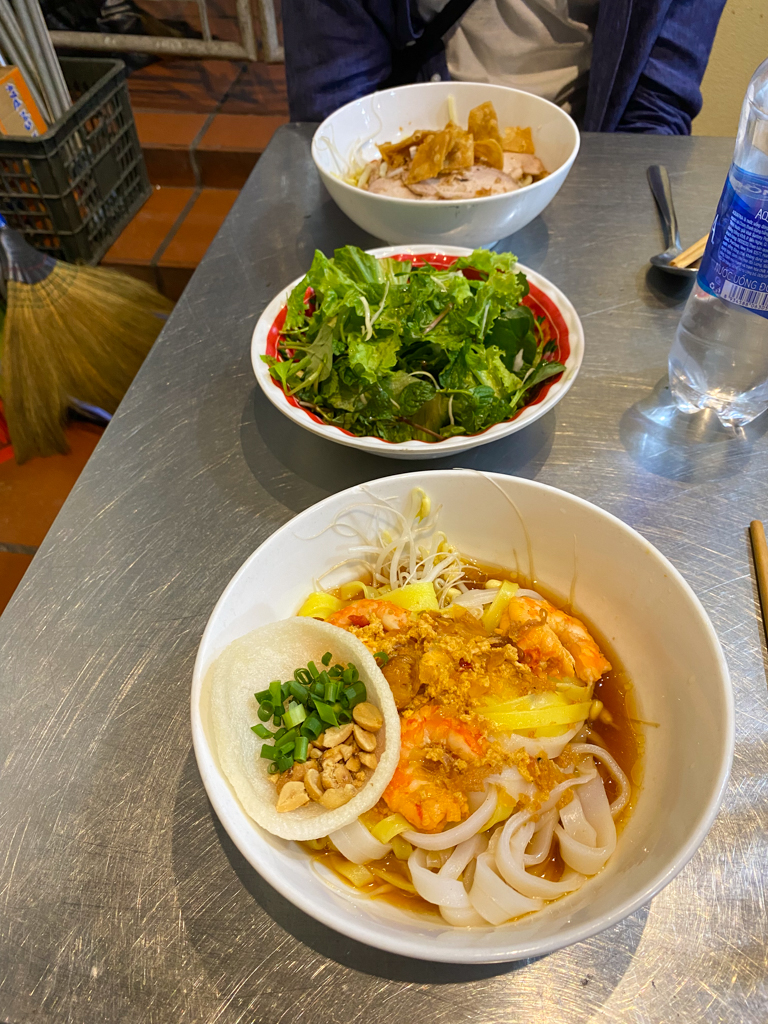 The town was again rammed with people, but we found peace at a place right in the middle of the chaos: Reaching Out Teahouse. The teahouse is a social enterprise that supports people with disabilities, in particular those hard of hearing. This is supported by a rule that the waiters do not speak and only communicate via printed words. You’re allowed to speak as a customer, but you’re asked to speak softly so as not to disturb the peaceful ambiance of the place. It was truly a magical way to end the day.
The town was again rammed with people, but we found peace at a place right in the middle of the chaos: Reaching Out Teahouse. The teahouse is a social enterprise that supports people with disabilities, in particular those hard of hearing. This is supported by a rule that the waiters do not speak and only communicate via printed words. You’re allowed to speak as a customer, but you’re asked to speak softly so as not to disturb the peaceful ambiance of the place. It was truly a magical way to end the day.
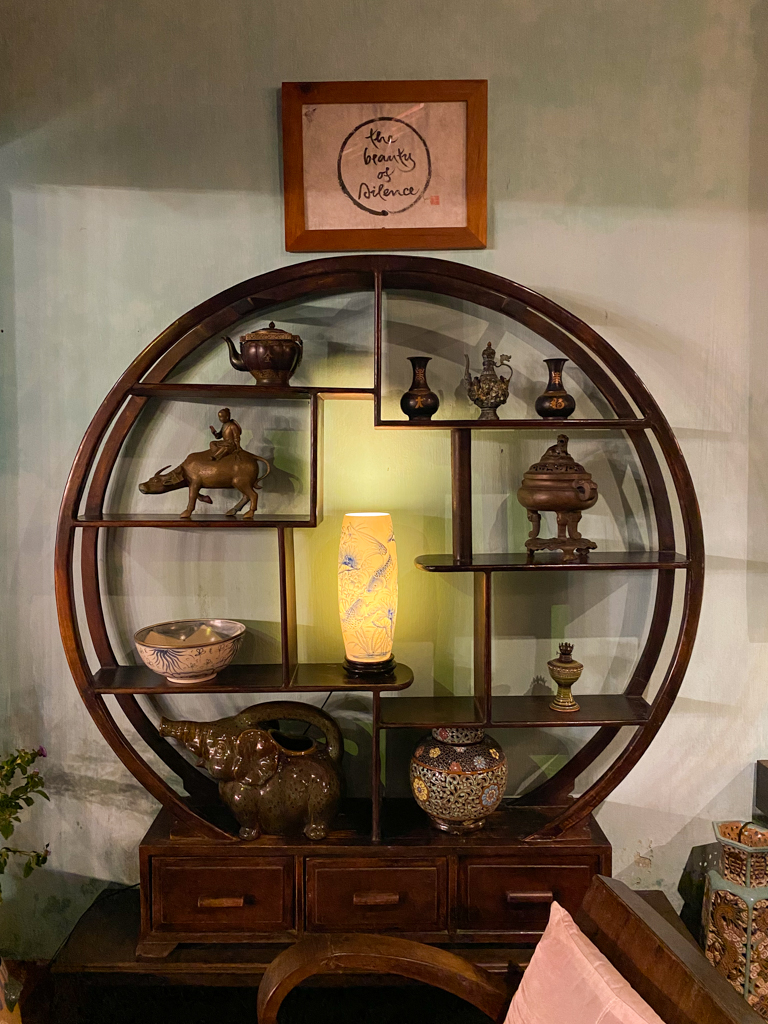
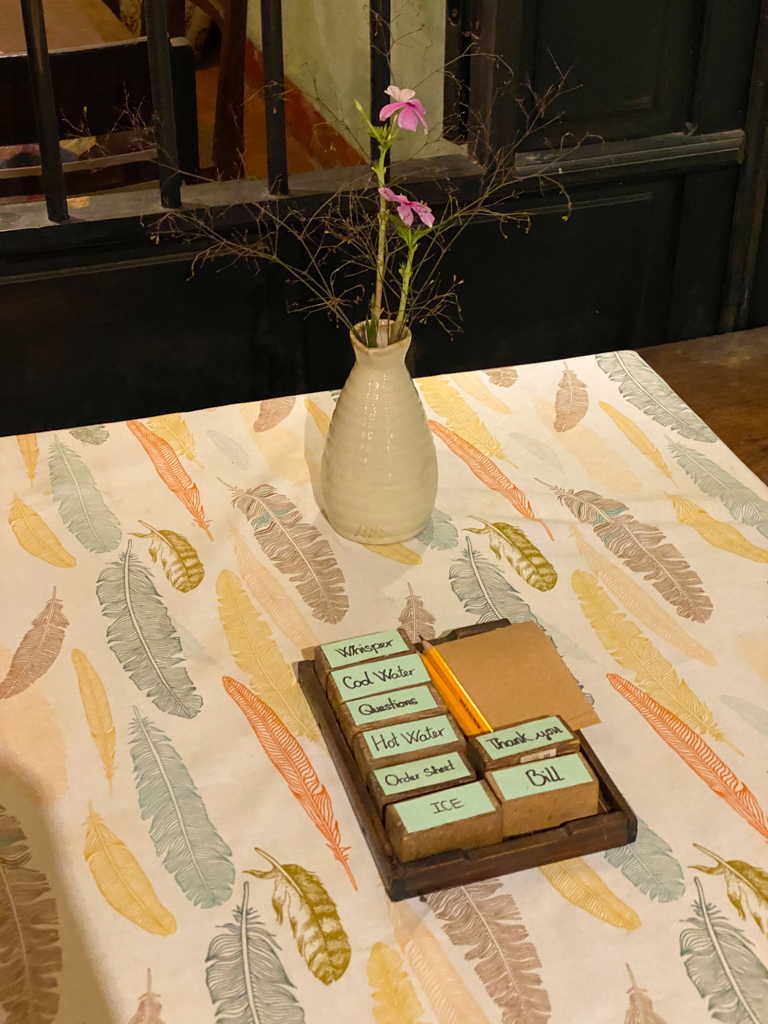

Despite the hordes of tourists and my severe sunburn, Hội An did have some beautiful buildings and charming streets, as well as some really good food. We also really enjoyed the bike ride to the beach and back as there were not many tourists around, a nice change from the town. All in all, I’m happy we stopped here to see what all the fuss was all about!
What do you think of Hội An? Would you visit despite (or because of) it being one of the most popular spots to visit in Vietnam?


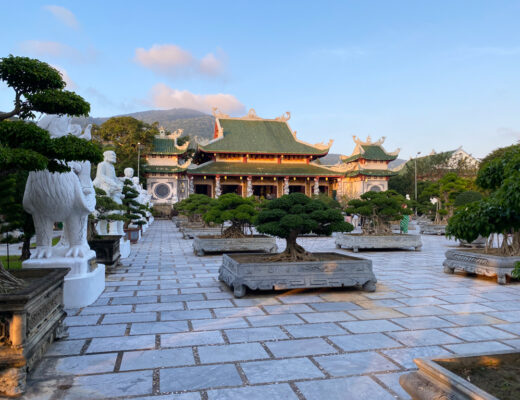

No Comments